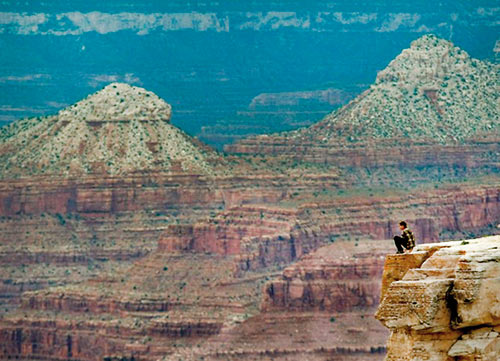Sunday Times 2
The belly of the Yellowstone beast
In the heart of Yellowstone National Park, a supervolcano releases around 45,000 metric tonnes of carbon dioxide each day.

The Yellowstone supervolcano is one of the largest active continental silicic volcanic fields in the world. Researchers said the upper magma chamber is believed to have been the source of three Yellowstone eruptions 2 million, 1.2 million and 640,000 years ago (Reuters)
But the magma chamber lying directly beneath its surface is not considered large enough to produce such levels, so researchers have been searching for an alternative source for years.
Now, by tracking seismic waves, a team of geophysicists has discovered an enormous secondary chamber deeper underground that’s so large its partly-molten rock could fill the Grand Canyon 11 times over.
The Yellowstone supervolcano is one of the largest active continental silicic volcanic fields in the world. Silicic is used to describe magma or igneous rock rich in silica.
It is situated in Yellowstone National Park – which spans the midwestern US states of Wyoming, Idaho and Montana – and last erupted 640,000 years ago.
Lava has flowed in the area as recently as 70,000 years ago, researchers added.
Experts say there is a one in 700,000 annual chance of a volcanic eruption at the site.
Previous research found a relatively small magma chamber, known as the upper-crustal magma reservoir, directly beneath the surface in 2013 that measures 2,500 cubic miles (10,420 cubic km).
To discover the latest chamber, Hsin-Hua Huang from the University of Utah and his colleagues tracked seismic waves from almost 5,000 earthquakes.
These readings combined data from the University of Utah Seismograph Stations, which collected shallow readings from nearby quakes in Utah, Idaho, the Teton Range and Yellowstone, and from the Earthscope array, which revealed deeper readings from temblors from more further afield.
Each of these quakes created waves that echoed around the supervolcano.

A tourist sits on a precipice while gazing out into the Grand Canyon. For comparison, the Grand Canyon in Arizona has a volume of 1,000 cubic miles (4,168 cubic km) meaning the molten rock in the upper chamber of Yellowstone would fill it two-and-a-half times, and the rock from the larger lower chamber would fill it 11 times (AFP)
The movement and structure of these waves could then be used to map the earth beneath.
The researchers said in their paper: ‘The Yellowstone magmatic system from the mantle plume to the upper crust’, published in the journal Science, that the reservoir contains around 98 per cent hot rock.
The remaining two per cent is molten rock and is too deep to directly cause an eruption, they added.
It sits 12 to 28 miles (19 to 45km) beneath the supervolcano and measures 11,035 cubic miles (46,000 cubic km).
To put this into perspective, the Grand Canyon in Arizona has a volume of 1,000 cubic miles (4,168 cubic km) meaning the molten rock in the upper chamber would fill it two-and-a-half times, and the rock from the larger lower chamber would fill it 11 times.
Not only do the findings reveal what is causing the high levels of carbon dioxide, researchers can use it to learn more about how the supervolcano connects to the hot-spot plume in Earth’s mantle.
It could also provide clues about the structure of other supervolcanoes.
‘An understanding of its properties is key to enhancing our knowledge of volcanic mechanisms and corresponding risk,’ said the researchers.
‘This lower-crustal magma body has a volume 4.5 times larger than the upper-crustal magma reservoir [and] these estimates are critical to understanding the evolution of basaltic-rhyolitic volcanism and explaining the magnitude of CO2 discharge.’
The presence of magma reservoirs underlying upper crust magma chambers has been inferred at other locations, but not detected.
The paper added that the upper magma chamber is believed to have been the source of three Yellowstone eruptions 2 million, 1.2 million and 640,000 years ago.
If Yellowstone did erupt, estimates from National Geographic suggest its immediate effects would kill around 87,000 instantly.
A 10-foot (3 metre) layer of ash would travel around 1,000 miles (1,610km), leaving two-thirds of the US uninhabitable.
This spread of volcanic ash, rocks and gas would then prevent planes from taking off and disrupt air travel around the globe.
‘The magma chamber and reservoir are not getting any bigger than they have been, it’s just that we can see them better now using new techniques,’ added co-author Jamie Farrell, a post-doctoral researcher at the University of Utah.
© Daily Mail, London
| WHAT WOULD HAPPEN IF YELLOWSTONE ERUPTED? Researchers said the upper magma chamber is believed to have been the source of three Yellowstone eruptions 2 million, 1.2 million and 640,000 years ago. If Yellowstone did erupt, estimates from aNational Geographic report said its immediate effects would kill around 87,000 instantly. A 10-foot (3 metre) layer of ash would travel around 1,000 miles (1,610km), leaving two-thirds of the US uninhabitable. This spread of volcanic ash, rocks and gas would then prevent planes from taking off and disrupt air travel around the globe. |

